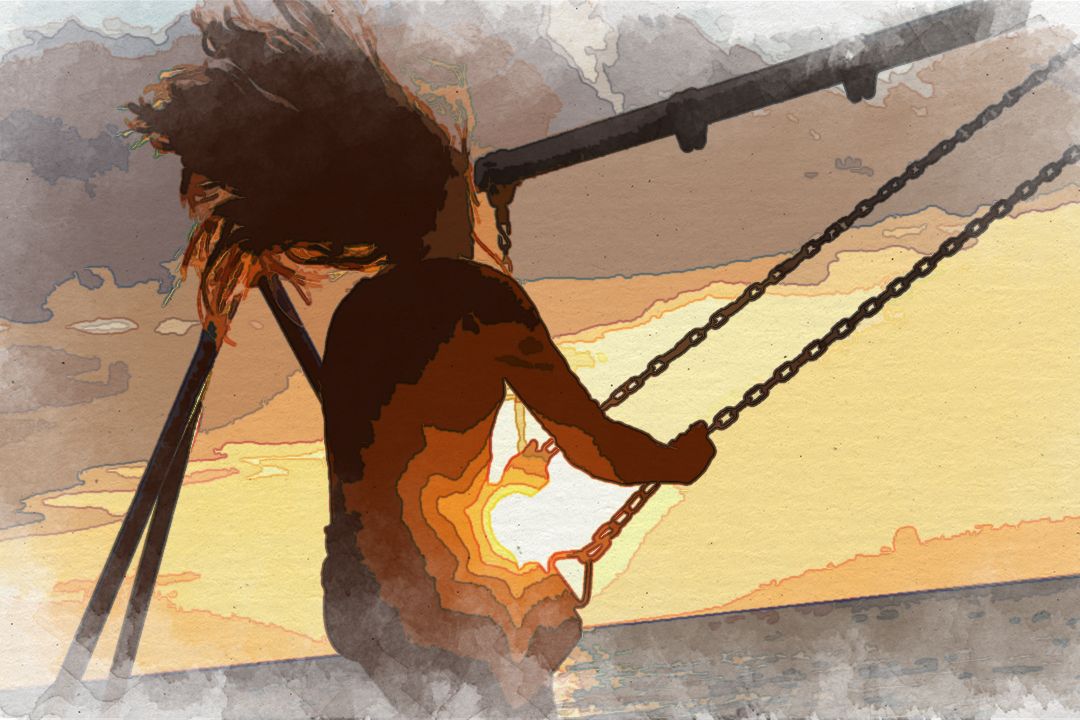Compassion Curators

A Philosopher's Lapidary Swinging a Chain Reaction to the Giver of Life
In the quietude of his study, Jonathan, an erudite philosopher and devoted reader, found himself surrounded by the ethereal dance of thoughts. His fingers traced the edges of the open notebook, a gateway to a realm where memories and philosophies converged, much like Plato's musings on knowledge as remembrance.
As the ink flowed onto the blank pages, Jonathan pondered the paradox embedded in Plato's teachings. Did the very act of remembering signify a gradual loss of knowledge, a fading echo of wisdom? The pendulum of his thoughts swung between the profound and the perplexing, leaving imprints in the notebook's margins.
The sun beckoned Jonathan from his contemplative retreat, casting its golden glow upon the outdoor swing. The rhythmic motion of the chain became a metaphorical dance, a chain reaction to the sun's life-giving force.
As the sun cast its golden hues upon the outdoor swing, Jonathan, the venerable philosopher, felt the warmth of its rays beckoning him from the contemplative cocoon of his study. The rhythmic motion of the swing's chain became a metaphorical dance, a harmonious response to the sun's life-giving force that permeated the tranquil afternoon.
In the midst of this atmospheric interplay, a figure emerged from the neighboring house, drawn by the allure of intellectual exploration and the soothing cadence of the swing. Dr. Eleanor Reynolds, a renowned scientist residing nearby, observed Jonathan's contemplative retreat from her own garden.
Dr. Reynolds, with her piercing gaze and the air of perpetual curiosity, was a distinguished molecular biologist whose work had garnered international acclaim. Her presence added a layer of depth to the tableau—science intersecting with philosophy in the enchanting realm of a sunlit backyard.
The swing, which had been a vessel for Jonathan's philosophical introspection, now became a point of convergence for the realms of thought and empirical inquiry. As Jonathan whispered to himself, invoking David Hume's timeless wisdom, Dr. Reynolds approached, her keen interest in the interplay between philosophy and the empirical world evident in the spark of curiosity in her eyes.
Be a philosopher but, amid all your philosophy be still a man.
— David Hume (1711-1776)
The swing, like a pendulum oscillating between two worlds, carried him through the realms of abstract contemplation and the tangible experiences of human existence.
Dr. Reynolds, recognizing the interweaving of thought and experience, joined Jonathan on the swing. The chain creaked in response to their shared weight, creating a harmonious duet between the philosopher and the scientist. Jonathan, now aware of his companion, greeted her with a warm smile, inviting her to partake in the dance of intellectual exploration.
As the swing continued its rhythmic motion, Jonathan and Dr. Reynolds engaged in a dialogue that bridged the realms of philosophy and science. They explored the parallels between Hume's philosophical insights and the scientific method, discussing how the pursuit of knowledge transcended disciplinary boundaries.
The golden glow of the sun enveloped them, casting long shadows that danced with the fluid exchange of ideas. The swing, once a solitary vessel for philosophical musings, now became a shared space where the synergy between thought and experimentation flourished.
The interaction between the philosopher and the scientist mirrored the quote that resonated in the air.
The meeting of two personalities is like the contact of two chemical substances: if there is any reaction, both are transformed.
— Carl Jung (1875-1961)
Their intellectual exchange, like a chemical reaction, sparked transformations in understanding, enriching both disciplines with new perspectives.
As the sun began its descent, Jonathan and Dr. Reynolds continued their discourse, their shared exploration extending beyond the swing into the realms of their respective domains. The backyard, bathed in the fading sunlight, witnessed the harmonious collaboration between philosophy and science—a testament to the limitless possibilities that arise when diverse disciplines converge in the pursuit of knowledge.
The swing, now a symbol of interdisciplinary dialogue, carried the philosopher and the scientist through the nuanced landscapes of thought and experience. Their voices, like a symphony of intellect, resonated in the tranquil evening air, weaving a narrative that transcended the boundaries between philosophy and science.
Leaving the philosophical abstractions behind, he reflected on the quote,
What can be added to the happiness of a man who is in health, out of debt, and has a clear conscience?
— Adam Smith (1723-1790)
The swing, a steadfast companion in the backyard of Jonathan's contemplative retreat, continued its rhythmic dance—a silent vessel that seamlessly transported him through the vast arc of life's pendulum. It evolved into a tangible metaphor, embodying the journey through the intricate tapestry of existence, where each sway became an odyssey navigating the contrasting landscapes between the pangs of life's struggles and the serene moments of contentment.
As the swing embarked on its upward trajectory, Jonathan felt the palpable resonance between the ascent and the peaks of life's challenges. It was as if each elevation mirrored the arduous climbs one faces in the rugged terrain of personal trials. The wind, a whispered companion, carried tales of adversity that intermingled with the rhythmic creaking of the chain—a testament to the resilience required to ascend from the depths of hardship.
With each upward movement, Jonathan sensed an undeniable shift within himself. The swing, now both a physical and metaphorical force, propelled him to gain a newfound perspective and strength. The ascent became more than a mere physical motion; it transformed into a symbolic act of resilience and growth. In the face of life's adversities, the swing became a conduit for empowerment, an instrument that not only bore the weight of Jonathan's struggles but also propelled him towards the summits of personal triumph.
The wind, carrying tales of both challenge and triumph, whispered encouragement as Jonathan soared higher. The creaking chain, echoing the resilience within, became a rhythmic melody—a soundtrack to the journey that unfolded with every oscillation. The swing, once a simple apparatus, had metamorphosed into a vessel of self-discovery and perseverance.
As the swing reached its zenith, the moments of suspension between ascent and descent provided a brief respite—a celestial pause where Jonathan could survey the expansive landscape of his experiences. It was in these suspended moments that he gained clarity, a panoramic view that encompassed both the conquered peaks and the valleys of introspection.
The swing, now an integral part of Jonathan's daily ritual, symbolized more than just a means of physical relaxation. It became a dynamic metaphor for the cyclical nature of life, where the ascent represented resilience, growth, and triumph over adversity. Each upward swing was a testament to the strength gained from navigating the challenging terrain of existence.
Jonathan, guided by the rhythm of the swing, found solace and inspiration in this simple yet profound act. The vessel that once carried him through the contrasting landscapes of life now served as a tangible reminder that, no matter how daunting the peaks or serene the valleys, the journey itself was a continuous evolution—a rhythmic dance between struggle and contentment, propelled by the unwavering motion of life's pendulum.
Life swings like a pendulum backward and forward between pain and boredom.
— Arthur Schopenhauer (1788-1860)
At the zenith of each swing, when gravity momentarily released its grip, Jonathan found solace in the suspension—a fleeting escape from the gravitational pull of life's burdens. It was in these suspended moments that he glimpsed the broader panorama of his experiences, gaining a profound understanding of the interconnectedness between the struggles and the triumphs.
The descent, on the other hand, brought a sense of surrender—a gentle acknowledgment of life's inevitable challenges. As the swing descended, Jonathan descended into the valleys of introspection, where the echoes of struggle intertwined with the whispers of self-discovery. The chain, bearing the weight of his thoughts, served as a conduit between the realms of challenge and contemplation.
In the quiet moments between each swing, as the pendulum paused before reversing its course, Jonathan found himself cradled in the arms of tranquility. These interludes were the pockets of respite, where he could reflect on the lessons learned during the ascent and prepare for the next descent. The swing, in these moments, became a sanctuary—a vessel navigating him through the ebb and flow of life's constant rhythm.
The sun, a silent witness to this pendulum dance, cast its warm glow upon Jonathan as he swung back and forth. It painted the sky with hues of resilience and illuminated the quiet corners of contentment that lay nestled within the broader arc of life's journey.
Rise like Lions after slumber In unvanquishable number — Shake your chains to earth like dew Which in sleep had fallen on you — Ye are many — they are few.
— Percy Bysshe Shelley (1792-1822)
With each swing, the vessel of the swing became a metaphor for the human experience—a journey through the highs and lows, the struggles and moments of peace. Jonathan, in the embrace of the swing, found harmony in the acknowledgment that life's pendulum, with its ceaseless motion, carried him through a symphony of emotions and experiences.
As he swung, the vessel of the swing guided him through the intricate dance of existence. It became a conduit for introspection, a means to navigate the complexities of being human. And in the cyclical rhythm of the pendulum's arc, Jonathan discovered the profound beauty that resides in the balance between life's struggles and the quiet moments of contentment. The swing became a symbol of defiance, shaking off the chains that bound his spirit and the collective human experience.
Her voice is full of money.
— F. Scott Fitzgerald (1896-1940)
Jonathan's musings turned to the complexities of human connections, where voices carried more than words—an intricate tapestry woven with emotions, aspirations, and perhaps, even the pursuit of wealth.
Jonathan's contemplations deepened, leading him into the intricate labyrinth of human connections. As he explored the complexities inherent in the web of relationships, he began to perceive that voices carried far more than mere words; they resonated with the symphony of emotions, aspirations, and perhaps, even the subtle undertones of the pursuit of wealth.
In the realm of human interactions, voices became the vessels of profound narratives, each intonation a brushstroke on the canvas of shared experiences. Beyond the surface of spoken language, emotions wove themselves into the fabric of communication, creating a tapestry that told stories of joy, sorrow, love, and ambition. It was as if every word spoken carried the weight of unspoken sentiments, contributing to the rich texture of the intricate tapestry of human connection.
Emotions, like threads of various hues, intertwined with spoken words, adding depth and nuance to the communication between individuals. Jonathan recognized that beneath the surface, every conversation was a dance of feelings, a delicate interplay of sentiments that shaped the texture of relationships. The warmth in a friend's greeting, the hesitancy in a colleague's voice—these subtleties enriched the communication, making it a nuanced expression of the human experience.
As he delved into the tapestry of human connections, Jonathan discerned the presence of aspirations interwoven with the spoken discourse. Dreams and desires, like golden threads, traversed the intricate patterns of communication. The voice, then, became a vehicle for the expression of personal goals and collective ambitions, contributing to the shared vision that bound individuals together.
Yet, amidst the emotional and aspirational threads, Jonathan also detected a subtler motif—the pursuit of wealth. In the cadence of voices, he discerned echoes of economic endeavors, financial aspirations, and the societal allure of prosperity. The pursuit of wealth, whether overt or concealed, played a role in shaping the dynamics of human connections, influencing decisions, and even steering the course of relationships.
The realization that wealth, too, was a motif in the intricate tapestry of human connections prompted Jonathan to reflect on the delicate balance between material pursuits and emotional bonds. It became evident that the pursuit of prosperity, while an integral part of societal dynamics, needed to be harmoniously interwoven with the more profound aspects of human relationships.
Jonathan's musings, like a weaver navigating the loom, led him to appreciate the multifaceted nature of human connections. Voices, beyond being conduits for words, carried the essence of shared experiences, emotional nuances, aspirations, and even the subtle influence of economic pursuits. The tapestry of human connections, he realized, was a masterpiece crafted from the interplay of these diverse elements—a living canvas that unfolded with every exchange, revealing the rich complexity inherent in the relationships that define the human experience.
As he returned to his study, Jonathan marvelled at the day's journey—a canvas painted with the hues of philosophical exploration and human experience. The notebook, now filled with the intricate dance of his thoughts, stood as a testament to the delicate balance between profound wisdom and the warmth of life's simple pleasures. The sun dipped below the horizon, leaving Jonathan to contemplate the vast expanse of knowledge yet uncovered, each word and idea waiting to be inscribed in the pages of his philosophical pursuit.
Fear prophets and those prepared to die for the truth, for as a rule they make many others die with them, often before them, at times instead of them.
— Umberto Eco (1932-2016)
There have been those who fervently embraced their roles as prophets, messengers of truth as they perceived it. These individuals, driven by an unshakable certainty in their beliefs, stood resolute in their commitment, often ready to sacrifice everything, even their lives, for the truths they held sacred.
However, the cautionary note suggests that while such conviction might be admirable, it can also carry a heavy toll. The call to "fear prophets" resonates with an acknowledgment of the potential dangers inherent in absolute certainty. Those who become prophets, with an unyielding faith in their version of the truth, may unintentionally become conduits for chaos and destruction.
The phrase implies that the fervor of a prophet, coupled with a willingness to die for their truth, may inadvertently lead to the loss of many other lives. The followers, inspired by the charisma and conviction of the prophet, might find themselves drawn into conflicts or situations where sacrifice becomes the norm. In some cases, these followers might lose their lives before the prophet, often in pursuit of a truth that may be subjective or unattainable.
Furthermore, the idea of prophets making others die "instead of them" suggests that the leaders, while espousing ideals worth dying for, may not always bear the brunt of the sacrifice themselves. The burden of martyrdom, in such instances, might fall disproportionately on the followers who, inspired by the prophet's teachings, willingly lay down their lives in the pursuit of a perceived higher truth.
In essence, the cautionary message encourages a discerning approach to those who wield absolute certainty and inspire followers to extreme measures. It prompts society to critically examine the potential consequences of blind allegiance to charismatic figures who claim to embody absolute truths. The call to "fear prophets" serves as a reminder that unchecked conviction, when wielded without consideration for the broader impact, can lead to unintended and profound consequences, potentially causing harm to both believers and those who may find themselves inadvertently caught in the crossfire of unwavering ideologies.

The planksip Writers' Cooperative is proud to sponsor an exciting article rewriting competition where you can win over $750,000 in prize money.
Figures of Speech Collection Personified
Our editorial instructions for your contest submission are simple: incorporate the quotes and imagery from the above article into your submission.
What emerges is entirely up to you!
Winners receive $500 per winning entry multiplied by the article's featured quotes. Our largest prize is $8,000 for rewriting the following article;

At planksip, we believe in changing the way people engage; at least, that's the Idea (ἰδέα). By becoming a member of our thought-provoking community, you'll have the chance to win incredible prizes and access our extensive network of media outlets that will amplify your voice as a thought leader. Your membership truly matters!


